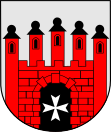Słońsk
| Słońsk | ||
|---|---|---|

|
|
|
| Basic data | ||
| State : | Poland | |
| Voivodeship : | Lebus | |
| Powiat : | Sulęciński | |
| Gmina : | Słońsk | |
| Geographic location : | 52 ° 34 ' N , 14 ° 48' E | |
| Height : | 23 m npm | |
| Residents : | 3000 (2004) | |
| Postal code : | 66-436 | |
| Telephone code : | (+48) 95 | |
| License plate : | FSU | |
| Economy and Transport | ||
| Street : | Berlin - Warsaw | |
| Next international airport : | Szczecin-Goleniów | |
Słońsk ( German Sonnenburg ) is a village belonging to the powiat Sulęciński ( Zielenziger district ) in the Polish voivodeship of Lubusz (town until 1947). The place is the seat of the rural municipality of the same name with 4755 inhabitants (as of June 30, 2019).
Geographical location
The village is located in the Neumark in the Warta lowland, south of the river and about 15 kilometers east of Kostrzyn nad Odrą (Küstrin) .
history
Sonnenburg was first mentioned in a document in 1295. The Knights Templar had a settlement in the city. In 1312 the Margrave of Brandenburg and the Bishop of Lebus were named as joint owners. Henning and Arnold von Uechtenhagen, who had received the Sonnenburg as a fief, built the first Sonnenburg Castle in 1341 . From the 15th century on, the history of Sonnenburg is closely linked to the Order of St. John , which acquired the settlement and castle in 1426 for 900 shock Bohemian groschen from Margrave Friedrich I of Brandenburg . The castle was the seat of the Lord Master of the Bailiwick of Brandenburg, which was relatively autonomously within the Order of St. John. The order did a lot for the expansion of Sonnenburg. From 1474 to 1522 the Johanniter built a new church and from 1545 to 1564 a new castle.
In 1538 Joachim II , Elector of Brandenburg, converted to Lutheran teaching. The Brandenburg ballot followed him and kept a large part of their possessions. In the Thirty Years War , the order castle and the place were badly destroyed. Between 1662 and 1667, Johann Moritz von Nassau-Siegen , who was appointed master master of the order in 1652, had a new residential palace built. The builder was the Dutchman Cornelis Ryckwaert .
Until the secularization in 1811, Sonnenburg remained under the rule of the order. After 1815 the place was in the district of Sternberg (after the division in 1873, the district of Oststernberg ). After the reestablishment of the Protestant Order of St. John, the castle became the seat of the master master and remained in the possession of the order until 1945.
In 1933 the previous prison was converted into the Sonnenburg concentration camp, which on January 31, 1945 became the scene of a German end- stage crime that killed more than 810 prisoners.
After the Second World War , the city was placed under Polish administration. The immigration of Polish migrants began, some of whom came from areas east of the Curzon Line conquered by Poland after the First World War . The German city of Sonnenburg was renamed Słońsk and the local population was expelled .
The town charter was revoked in 1947. Many buildings, including the Johanniter Hospital, were demolished in order to obtain building material for the reconstruction of Warsaw. The castle fell victim to an intentional arson in 1976 and still dominates the cityscape as a ruin.
local community
The rural community (gmina wiejska) Słońsk includes the village itself and other villages with school offices. One third of the municipality belongs to the Warta Estuary National Park , one of the largest bird sanctuaries in Europe.
Town twinning
Office Schlaubetal (Brandenburg)
Personalities
- Born in Sonnenburg
- Andreas Knopke , (* 1468), theologian and reformer of Riga
- Christian Friedrich Schwartz , (* 1726), missionary in India
- Hans Eberhard Buchholz , (* 1933), 1967–1997 director of the Institute for Agricultural Market Research at the Federal Research Center for Agriculture.
- Personalities who worked in the place
- Wilhelm Speck (1861–1925), writer, poet, Protestant pastor and educator as well as prison chaplain in Sonnenburg.
literature
- Heinrich Berghaus : Land book of the Mark Brandenburg and the Margraviate Nieder-Lausitz in the middle of the 19th century . Volume 3, 1st edition, Brandenburg 1856, pp. 261-265 ( online ).
- Eduard Ludwig Wedekind : Sternbergische Kreis-Chronik. History of the cities, towns, villages, colonies, castles etc. of this part of the country from the earliest past to the present . Zielenzig 1855, pp. 203-207.
- Paul von Niessen: The Johanniterordensballei Sonnenburg and Margrave Johann von Brandenburg . Schaeffer, Landsberg / Warthe 1913 ( publications of the Association for the History of Neumark. 29/30, ZDB -ID 500750-1 ).
Web links
Individual evidence
- ↑ For general information on the complete expulsion of the residents of the historic Neumark, see Paweł Rutkowski (ed.): Streifzüge between Oder and Drage. Encounter with the Neumark. German Cultural Forum, Potsdam 2012, ISBN 978-3-936168-44-0 , p. 14f. For the beginning of the expulsion in the border areas before the Potsdam conference see Detlef Brandes (Hrsg.): Lexikon der Vertriebs. Deportation, Forced Relocation, and Ethnic Cleansing in 20th Century Europe . Böhlau, Vienna / Cologne / Weimar 2010, ISBN 978-3-205-78407-4 , pp. 726–728.





